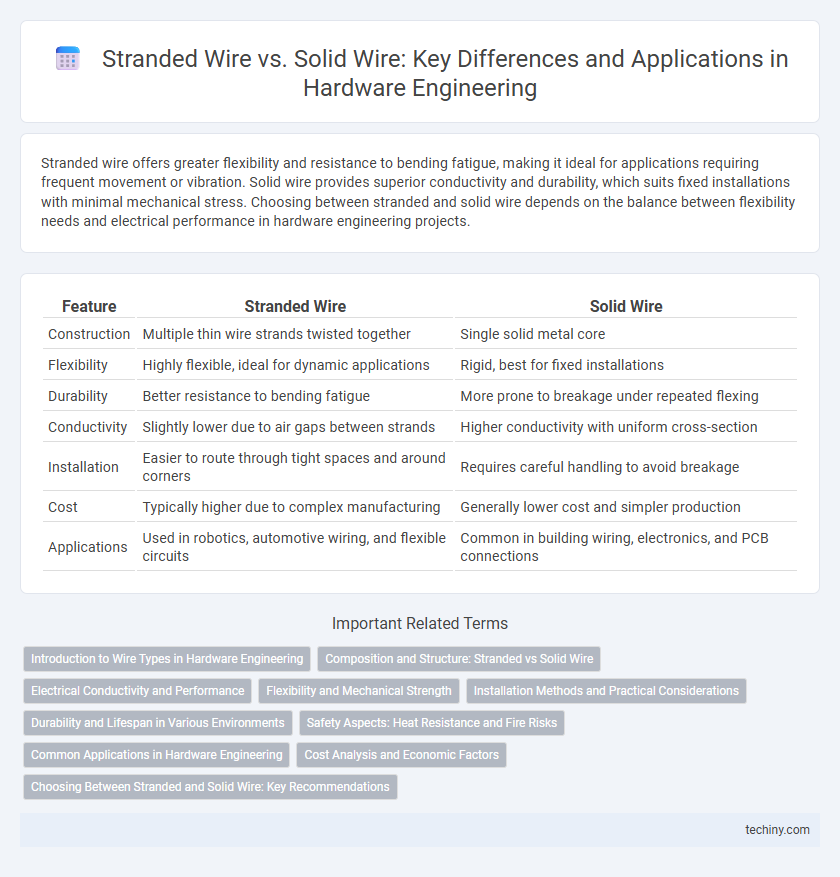Stranded wire offers greater flexibility and resistance to bending fatigue, making it ideal for applications requiring frequent movement or vibration. Solid wire provides superior conductivity and durability, which suits fixed installations with minimal mechanical stress. Choosing between stranded and solid wire depends on the balance between flexibility needs and electrical performance in hardware engineering projects.
Table of Comparison
| Feature | Stranded Wire | Solid Wire |
|---|---|---|
| Construction | Multiple thin wire strands twisted together | Single solid metal core |
| Flexibility | Highly flexible, ideal for dynamic applications | Rigid, best for fixed installations |
| Durability | Better resistance to bending fatigue | More prone to breakage under repeated flexing |
| Conductivity | Slightly lower due to air gaps between strands | Higher conductivity with uniform cross-section |
| Installation | Easier to route through tight spaces and around corners | Requires careful handling to avoid breakage |
| Cost | Typically higher due to complex manufacturing | Generally lower cost and simpler production |
| Applications | Used in robotics, automotive wiring, and flexible circuits | Common in building wiring, electronics, and PCB connections |
Introduction to Wire Types in Hardware Engineering
Stranded wire consists of multiple small gauge wires twisted together, offering enhanced flexibility and resistance to vibration, making it ideal for applications requiring frequent movement or bending. Solid wire is a single, solid conductor that provides better conductivity and is easier to terminate, commonly used in static or fixed installations. Understanding the physical properties and electrical characteristics of stranded versus solid wire is crucial for selecting the appropriate wire type in hardware engineering projects.
Composition and Structure: Stranded vs Solid Wire
Stranded wire consists of multiple small gauge wires twisted together, enhancing flexibility and resistance to metal fatigue, whereas solid wire is a single, thick conductor providing maximum conductivity and durability. The composition of stranded wire allows better vibration resistance and easier bending in complex circuit layouts, making it ideal for dynamic environments and moving parts. Solid wire's uniform cross-section ensures stable electrical contact and lower resistance, suitable for fixed installations requiring long-term reliability.
Electrical Conductivity and Performance
Stranded wire exhibits higher flexibility but slightly lower electrical conductivity compared to solid wire due to increased resistance at the multiple contact points between strands. Solid wire offers superior conductivity and lower resistance, making it ideal for high-performance electrical circuits requiring minimal signal loss. The choice between stranded and solid wire significantly impacts overall electrical performance, especially in applications subject to frequent movement or vibration.
Flexibility and Mechanical Strength
Stranded wire offers superior flexibility due to its multiple small gauge wires twisted together, making it ideal for applications requiring frequent movement or bending. Solid wire provides greater mechanical strength and durability, making it suitable for fixed installations where rigidity and robust conductivity are essential. Selecting between stranded and solid wire hinges on the balance between flexibility needs and mechanical strength requirements in hardware engineering projects.
Installation Methods and Practical Considerations
Stranded wire offers greater flexibility, making it ideal for applications requiring frequent movement or bending, such as in robotics or mobile devices. Solid wire provides a more rigid structure, suitable for fixed installations like building wiring where stability and ease of termination are essential. Installation methods for stranded wire often involve using ferrules or specialized connectors to prevent fraying, while solid wire can be directly inserted into terminal blocks for secure connections.
Durability and Lifespan in Various Environments
Stranded wire offers superior flexibility and resistance to metal fatigue, making it more durable in environments subject to vibration and movement, which extends its lifespan compared to solid wire. Solid wire, with its single solid conductor, provides higher tensile strength and durability in stable, stationary installations, but it can become brittle and prone to breakage under repeated flexing or harsh environmental conditions. In corrosive or outdoor environments, both stranded and solid wires benefit from protective insulation, but stranded wire's inherent resilience against mechanical stress typically results in longer operational life.
Safety Aspects: Heat Resistance and Fire Risks
Stranded wire offers superior heat dissipation compared to solid wire due to its multiple smaller strands, reducing the risk of overheating and fire hazards in electrical systems. Solid wire tends to retain heat longer under high current loads, increasing the potential for insulation damage and fire. Proper selection of stranded wire enhances safety by maintaining lower temperatures and minimizing fire risks in hardware engineering applications.
Common Applications in Hardware Engineering
Stranded wire is preferred in hardware engineering for applications requiring flexibility and frequent movement, such as robotics, connectors, and cable harnesses in electronic devices. Solid wire is commonly used in static installations like circuit boards, PCBs, and permanent wiring due to its rigidity and ease of soldering. Both wire types serve distinct roles based on mechanical durability and electrical conductivity needs in hardware design.
Cost Analysis and Economic Factors
Stranded wire generally incurs higher material and manufacturing costs compared to solid wire due to increased complexity in production and greater copper usage. Despite the premium, stranded wire offers enhanced flexibility and durability, potentially reducing maintenance and replacement expenses over time. Solid wire, being cheaper and easier to terminate, remains cost-effective for fixed installations with minimal movement, making it an economically viable choice in static hardware engineering applications.
Choosing Between Stranded and Solid Wire: Key Recommendations
Choosing between stranded wire and solid wire depends on application requirements; stranded wire offers superior flexibility and vibration resistance ideal for movable equipment, while solid wire provides lower resistance and better conductivity suited for fixed installations. For circuits exposed to frequent bending or mechanical stress, stranded wire prevents breakage, whereas solid wire ensures stable connections in static environments. Evaluating factors like current load, mechanical stress, and installation conditions ensures optimal wire selection for hardware engineering projects.
Stranded wire vs Solid wire Infographic

 techiny.com
techiny.com